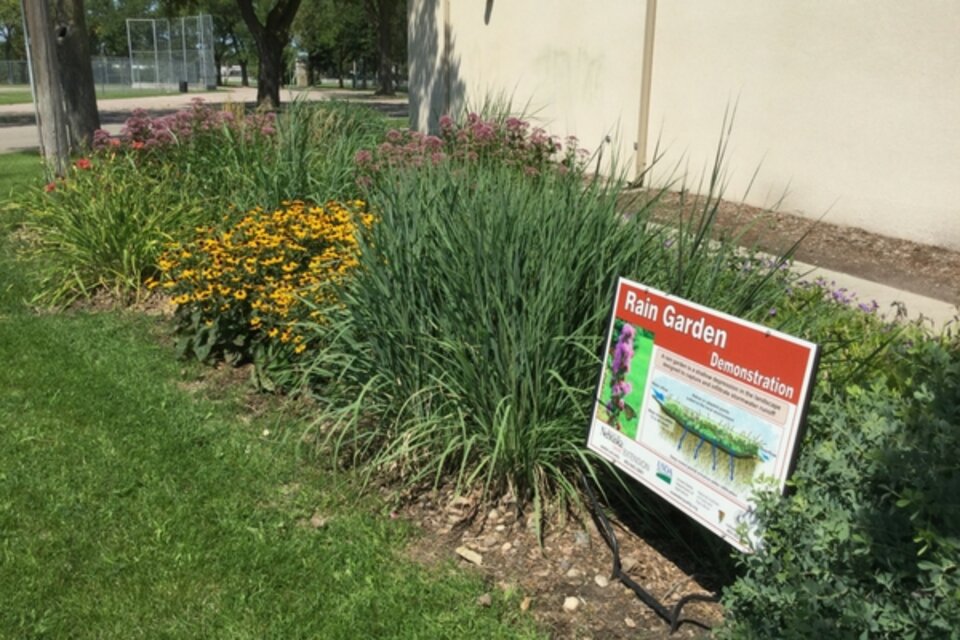Rain Garden Hydrologic Performance Depends on Proper Design and Installation

Rain gardens are an aesthetic feature of your residential landscape that also has a hydrologic function. Hydrologic means related to water. A properly designed and constructed rain garden for a residential landscape (no underground drainage system) is designed like a bathtub to hold water and let it slowly seep into the soil beneath the garden. This water is available for plant growth, and this water is removed from runoff that leaves your yard and does not contribute to downstream flooding or pollution. How well does your rain garden serve its hydrologic function? It should hold an amount of water equal to what comes off your roof from a 1.0-1.25 inch rainfall, and a rain garden full of water should infiltrate that water, that is, the water should disappear into the soil in 24-48 hours.
A UNL study evaluated the hydrologic performance of eleven (11) established residential rain gardens in Lincoln, Nebraska. These rain gardens were 2-4 years old. On average, the rain gardens retained only 40% of the water from a 1.25 inch rainfall. More specifically, only 16% of the water retained was held in the garden above the soil when the rain gardens were full, the bulk of the water held by the rain garden was accounted for in subsurface storage as water infiltrated below the soil surface. Subsurface storage is where water should go, but the low percent of water stored on the surface indicates these gardens are not reaching their design hydrologic performance.
This UNL study showed that soil infiltration rate and drain time are not the limiting factor to hydrologic performance. All the gardens drained “dry” within the recommended 24-48 hours. The hydrologic performance was limited by the gardens being undersized and unevenly graded, so they could not hold the water from a 1.25 inch rainfall (this is the recommended design rainfall for Lincoln, others areas in Nebraska may have a different value).
The average maximum depth of water in the rain gardens when they were full was only 4.0 inches, which is less than the 6.0 inch minimum rain garden depth recommended in Nebraska. Also, rain gardens were not built with enough surface area to hold the water, even if they were 6 inches deep.
What about simply digging a small rain garden deeper to improve hydrologic performance? Deeper rain gardens require more soil disposal, require more time and labor, and may not integrate as fluidly with existing landscapes. There also may be potential safety issues associated with digging too deep on private property (e.g. buried utilities, mosquito breeding habitat creation). For these reasons, adequate water holding capacity is best obtained by expanding the basin area, or footprint. If the space you intend to put your rain garden is too small for the proper footprint, you could consider two rain gardens in series, letting the first garden fill and drain into the second.
Lastly, the bottom topography of the rain gardens was highly variable. Frequently, areas within the rain gardens were never fully inundated or even wet! Highly variable construction grading limits hydrologic performance.
If you are planning a residential rain garden, be sure to properly size the garden for both depth and surface area. And work closely with your installer to be sure they properly build the rain garden berms to the correct depth and grade the bottom level. Proper hydrologic performance of your rain garden will increase the water capture, pollutant removal, and erosion prevention.
For information about rain garden design, see the UNL Extension circular, EC1262, available as an interactive PDF document at: http://extensionpublications.unl.edu/assets/pdf/ec1262.pdf. For information about installing your own residential rain garden, see UNL NebGuide G1760, available as a PDF document at: http://extensionpublications.unl.edu/assets/pdf/g1760.pdf.
This article was reviewed by Nicole Stoner